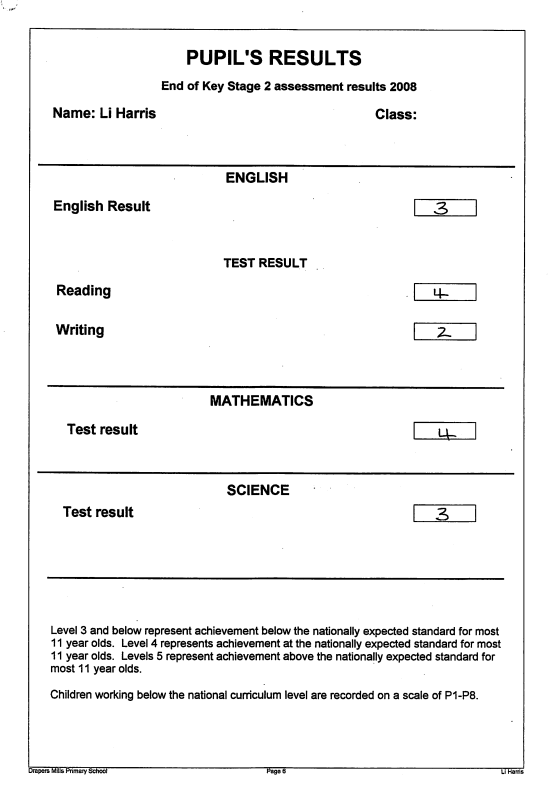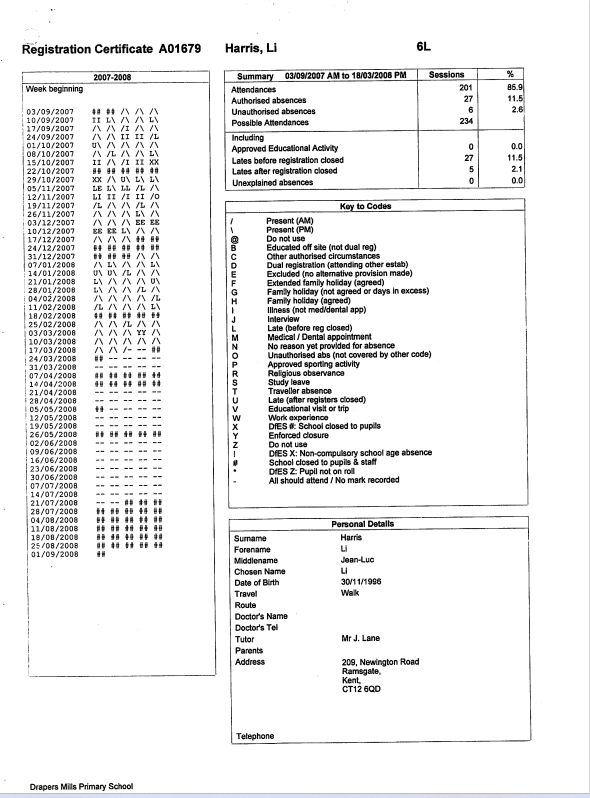OVERALL EFFORT FOR THE YEAR A = working very hard; B = good effort: C = satisfactory effort: D = poor effort: E = only works when pushed. PROCRESS (relative to your child’s ability) 1 = making good progress: 2 = making satisfactory progress; 3 = making poor progress. OVERALL BEHAVIOUR FOR THE YEAR A = behaves well all the time; B = behaves well most of the time; C = satisfactory behaviour: D = some behaviour concerns: E = disrupts teaching and learning Medical Note(s) Ethnicity: Home Language: White – English English Religion: Data Protection Act 1998: The school is registered under the Data Protection Act for holding personal data. The school has a duty to protect this information and to keep it up to date. The school is required to share some of the data with the Local Authority and with the DfES. No Religion Signature; Date: //.,/, . Literacy Li uses the techniques of dialogic talk to explore ideas, topics or issues. He makes notes when listening for a sustained period and can discuss how note-taking varies depending on context and purpose. He can identify the ways spoken language varies according to differences in the context and purpose of its use. He considers examples of conflict and resolution, exploring the language used. He understands and uses a variety of ways to criticise constructively and respond to criticism. He is able to improvise using a range of drama strategies and conventions to explore themes such as hopes, fears and desires. He can spell familiar words correctly and employs a range of strategies to spell difficult and unfamiliar words. He can appraise a text quickly, deciding on its value, quality or usefulness. He explores how word meanings change when used in different contexts. He can sustain engagement with longer texts, using different techniques to make the text come alive. He is able to compare how writers from different times and places present experiences and use language. He uses different narrative techniques to engage and entertain the reader. He is able to integrate words, images and sounds imaginatively for different purposes. He uses paragraphs to achieve pace and emphasis. He uses punctuation to clarify meaning in complex sentences. He uses different styles of handwriting for different purposes with a range of media, developing a consistent and personal legible style. He can select from a wide range of ICT programs to present text effectively and communicate information and ideas. Numeracy Li can represent and interpret sequences, patterns and relationships involving numbers and shapes. He is able to explain reasoning and conclusions, using words, symbols or diagrams as appropriate. He is able to find the difference between a positive and a negative integer, or two negative integers, in context. He can express a larger whole number as a fraction of a smaller one (e.g. recognise that 8 slices of a 5-slice pizza represents 8/5 or 1 3/5 pizzas). He is able to solve simple problems involving direct proportion by scaling quantities up or down. He uses his knowledge of place value and multiplicationfacts to 10 x 10 to derive related multiplication and division facts involving decimals (e.g. 0.8 x 7, 4.8 6). He uses a calculator to solve problems involving multi-step calculations. He can describe, identify and visualise parallel and perpendicular edges or faces, using these properties to classify 2-D shapes and 3-D solids. He is able to estimate angles, and use a protractor to measure and draw them, on his own and in shapes. He can select and use standard metric units of measure and convert between units using decimals to two places (e.g. change 2.75 litres to 2750ml, or vice versa). He can calculate the perimeter and area of rectilinear shapes and can estimate the area of an irregular shape by counting squares. He is able to describe and predict outcomes from data using the language of chance or likelihood. He constructs and interprets frequency tables, bar charts with grouped discrete data, and line graphs and interpret pie charts. Science This year in Science we have been studying interdependence and adaptation. He recognises that green plants are the source of food for all animals and that they produce material for new growth from air and water in the presence of light. He can describe evidence that yeast is living. He can explain how micro-organisms can move from one food source to another and how this can cause food poisoning. He presents results in a line graph where appropriate. He can explain why it is important to repeat measurements and how to deal with repeated results when drawing a graph. He can explain that in some cases the new materials made are gases and can identify some evidence eg vigorous bubbling for the production of gases. He can describe and explain the motion of some familiar objects in terms of several forces acting on them. He can explain the difference between shadow formation and reflection in terms of the path of light. He can Interpret more complex circuit diagrams and describe the differences between wires usually used for circuits and fuse wires. Drapers Mills Pnmary School Page 2 Li Harris Physical Education In gymnastics we have worked on our apparatus skills, discovering ways of moving on, through and around in linked sequences. Dance has been taught by Mr Friday learning sequences linked to ‘pop’ songs and musicals. The lessons have built upon knowledge and allowed progression to be shown and made. We have all developed our swimming skills learning to travel effectively over the water and develop confidence when around water. Religious Education We began the year by learning about Christian Religious buildings and the importance of the Christian Church in the community. We visited our local church of St. John the Baptist and Holy Trinity Church to learn about their design,. History and how they are used by different groups of the community for worship, social activities. And for guidance and support – both in practical and spiritual terms. We learned about the importance and symbolism of Baptism and the Sacrament to Christians, in the second term we researched the Christmas and Easter stories in more depth from the New Testament texts. In order to understand the symbolism within the story. We completed a comparative study of the Gospels of Matthew, mark, Luke and John. We learned about the main elements – and discrepancies – in the story of Easter;. From Good Friday and the Resurrection to the Ascension of Christ. We again looked at symbolism and the importance of personal faith and evangelism to Christians. Our next project was to learn about Sikhism by investigating its origins, its fundamental beliefs,. The Ten Gurus, the Sikh place of worship, the importance of the 5Ks and the Sikh Holy Book. Music General Musicianship skills have been developed using rhythmic rounds and activities. All children have been introduced to the families of the orchestra. They have been taught formal ‘language’ of music using interactive software and are able to identify and use formal notation. In line with ‘Wider Opportunities’ all pupils have been taught to read and compose tunes on roll-up keyboards. They have also composed using the range of functions available. Foundation Subjects (DT, ICT, History, Geography, Art and Design) This year these subjects have been incorporated in topics from the International Primary Curriculum. We began with the topic of ‘Learning to Learn’ which enabled us to develop a wide range of research skills centred round research skills and learning styles. This was followed by the project ‘Go with the Flow’ entailed a study of the Severn and the Nile which helped us to learn about the features of different river systems. We learned about the importance of these rivers to the local people for agriculture, industry and energy; and as a habitat for a range of animals. We considered the need for conservation and the effects on the landscape in the light of modern developments. We used ICT to create a database on World Rivers and compiled a magazine report in a Word document. During the ‘Our Place in Space’ we learnt about space travel, historic moments and researched key facts about the different planets in out Solar System. We used our learning to create multimedia PowerPoint presentations incorporating text, graphics, images and special effects. In the current term we have been studying two projects, ‘Growing Up’ which helps us to understand the physical and emotional changes in puberty, sex education and the importance of creating caring relationships. Added to this, in P.S.H.E. we have learned about attitudes and actions which produce good citizens within a community. Our final project is an Art and Design based topic looking at the works of different artists within a historical context; learning about their lives, their personal styles and techniques. We have developed our artistic skills to create our own art and craft with a range of media. General Comments and Personal, Social and Emotional Development Behaviour [ E ] Effort [ D ] Progress [3 ] Drapers Mills Primary School Page 3 Li Harris General Comments and Personal, Social and Emotional Development (continued) Li has had a troubled year and has moved class quite late on in year 6. Li finds it hard coping v^ith the whole class environment and will often choose to exit the class room if any form of confrontation exists. LI is an excellent reader and if he chooses to participate is an extremely capable boy across the curriculum. I personally wish him the very best at his new school. Targets for Next Year Reading Li needs to try and read a variety of genre at home Writing Li needs to form his letters correctly so the reader has an opportunity to read what has been written. Numeracy Li needs to learn his times tables so they become known facts. Science Li should try and consolidate his scientific vocabulary.



0 Comments